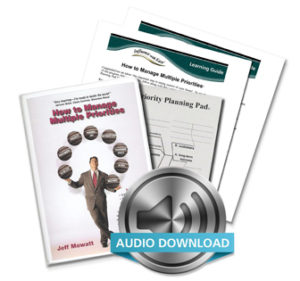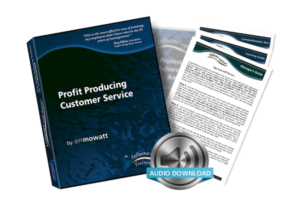Yes, I Mind Waiting
10 ways to reduce lineup stress for staff and customers
How do you let a cashier know that you’re in a hurry when you’re waiting in line?
- a) look at you watch and shake your head,
- b) sigh, huff, and roll your eyes,
- c) complain to others in the line,
- d) say to the person at the till, “We’re in a hurry here!”,
- e) all of the above.
If you answered positively to any of these options, then you’re like most of us who definitely do mind waiting. Lineups are frustrating. They are barriers that prevent customers from fulfilling necessary and often tedious tasks. That means that if you don’t manage your lineups properly, you’ll lose business due to customer frustration. Not to mention your staff will be stressed-out. That’s a lose/lose scenario.
Most managers think the best way to manage a lineup is to get the staff to work faster. Often, this only creates worse problems. Consider the impact on your staff of trying to work at full speed. It’s impossible to go flat-out without eventual burn-out. Morale drops. Turnover increases. Tired employees make more mistakes; which take even more time to fix.
Ditto for the negative impact of working faster on your customers. Only a fool would want tired, aggravated employees interacting with customers. Working faster to get through a line-up cuts short the human interaction that creates customer feelings of loyalty.
In the long term, working faster doesn’t work. Instead, we need ways to reduce the stress of lineups for both customers and staff — without working faster. Here are ten:
1. Warn the customer in advance.
Ever been frustrated by the long waiting-room lineup to see a doctor? (I, know — stupid question). Though delays can happen for legitimate medical reasons, some doctor’s offices reduce patient frustration by phoning in advance and warning them of the delay.
If your customer calls and says that they plan to come in, suggest the best times for them to drop-in to avoid waiting.
2. Schedule time for preparatory tasks.
If you know the customer will have some “preliminaries” when they arrive — such as filling out forms, suggest that they arrive early to complete them before the scheduled appointment or event.
3. Acknowledge people entering the line.
Too often, the first time the employee acknowledges the customer is when they get to the front of the line. That means a person who wants to spend money is being deliberately ignored. Lousy strategy. Instead, acknowledge customers with a “Hi there!” or “I’ll be with you in just a few minutes!” as they enter the lineup.
4. Organize the line.
Often, people don’t mind waiting if they can avoid standing in line and yet still keep their place. Some restaurants and medical offices give customers pagers so they can go shopping while they wait. They’re paged just before it’s their turn.
5. Distract and entertain the customer.
A sociology experiment found that the best way to speed up a slow elevator was not to add a faster motor. Instead, they added mirrors to the inside of the elevator. People got so caught up in looking at themselves that they thought the ride was twice as fast. Lesson: you can reduce the perceived length of the lineup with a distraction. Examples:
- Restaurants could offer reading material to people who are dining alone.
- Disney theme parks provide video updates about the ride you waiting for.
- Any unusual conversation piece will take your customer on a mental holiday. An Orlando hotel distracts guests waiting to register by herding live ducks to the fountain in the lobby.
6. Provide comfort.
Provide seating, food and drink. On busy Saturdays, a Calgary car wash brings you free pop and hot dogs while you wait in your vehicle.
7. Amuse the kids.
Prevent frazzled nerves for everyone by providing a play area for toddlers. Parents will love you for it.
8. Update the customer on progress.
Even if you’re not completely ready for the customer, you can still let them know you’re working on their behalf. A travel agent, for example, can phone the client to inform them that they’ve booked the flights, and are working on the hotel.
9. Explain unusual delays.
If it’s an unusually long delay, apologize to the customer, explain the delay and thank them for waiting. When a pharmacist explained to me that his assistant had quit that day, so he was short-staffed, I didn’t mind the wait. If he hadn’t pointed that out, I wouldn’t have returned.
10. Increase staff at no extra cost.
If your lineups are sporadic you can increase capacity on the spot without spending extra money. Carol Chuback, manager of a Greyhound Courier Depot, installed a doorbell under the cashier’s counter. When the teller notices more than two people in line, he discretely rings the doorbell signalling to a co-worker in the back to come to assist at the front counter.
Bottom line — no one likes lineups.
But that’s no reason to ask staff to burn themselves out. By getting creative you’ll boost your repeat business, and you’ll make the buying experience more pleasant for everyone. That’s what I call win/win.
Written by Jeff Mowatt (original content – not AI generated)
Was this helpful? For additional information on this topic: Manage Waiting Lines, Line-Ups, and Multiple Customers
You’ll find more of Jeff’s Trusted Advisor Customer Service tips or subscribe to receive a new Business Building Tip every two weeks.
If you’re interested in acustomized presentation for your organization, contact Jeff at [email protected]
Jeff Mowatt is a customer service speaker, customer service training professional, award-winning speaker, and best-selling author. To inquire about engaging Jeff for your team visit www.JeffMowatt.com
Other recommendations that would complement this topic:

How to Manage Multiple Priorities: It seems there’s never enough time in the day. There are often so many competing demands and interruptions in life that it’s easy to become busy – but not necessarily productive. That means the important things get put-off. Things start piling up. People get upset. Eventually, your work, health, and even relationships suffer.
 “Profit Producing Customer Service” in today’s competitive marketplace your team’s customer service is often your greatest differentiator. The challenge is ensuring that everyone gets consistent training on how to deliver one-of-a-kind service, where price becomes less relevant. This training package reveals how employees can provide REMARKable service.
“Profit Producing Customer Service” in today’s competitive marketplace your team’s customer service is often your greatest differentiator. The challenge is ensuring that everyone gets consistent training on how to deliver one-of-a-kind service, where price becomes less relevant. This training package reveals how employees can provide REMARKable service.
You can find more of Jeff’s training resources under Shopor should you be interested in having Jeff present a customized presentation for your organization contact Jeff at[email protected]

